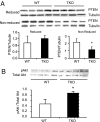Txnip balances metabolic and growth signaling via PTEN disulfide reduction
- PMID: 18322014
- PMCID: PMC2268825
- DOI: 10.1073/pnas.0800293105
Txnip balances metabolic and growth signaling via PTEN disulfide reduction
Abstract
Thioredoxin-interacting protein (Txnip) inhibits thioredoxin NADPH-dependent reduction of protein disulfides. Total Txnip knockout (TKO) mice adapted inappropriately to prolonged fasting by shifting fuel dependence of skeletal muscle and heart from fat and ketone bodies to glucose. TKO mice exhibited increased Akt signaling, insulin sensitivity, and glycolysis in oxidative tissues (skeletal muscle and hearts) but not in lipogenic tissues (liver and adipose tissue). The selective activation of Akt in skeletal muscle and hearts was associated with impaired mitochondrial fuel oxidation and the accumulation of oxidized (inactive) PTEN, whose activity depends on reduction of two critical cysteine residues. Whereas muscle- and heart-specific Txnip knockout mice recapitulated the metabolic phenotype exhibited by TKO mice, liver-specific Txnip knockout mice were similar to WT mice. Embryonic fibroblasts derived from knockout mice also accumulated oxidized (inactive) PTEN and had elevated Akt phosphorylation. In addition, they had faster growth rates and increased dependence on anaerobic glycolysis due to impaired mitochondrial fuel oxidation, and they were resistant to doxorubicin-facilitated respiration-dependent apoptosis. In the absence of Txnip, oxidative inactivation of PTEN and subsequent activation of Akt attenuated mitochondrial respiration, resulting in the accumulation of NADH, a competitive inhibitor of thioredoxin NADPH-reductive activation of PTEN. These findings indicate that, in nonlipogenic tissues, Txnip is required to maintain sufficient thioredoxin NADPH activity to reductively reactivate oxidized PTEN and oppose Akt downstream signaling.
Conflict of interest statement
The authors declare no conflict of interest.
Figures






Similar articles
-
Thioredoxin-interacting protein (Txnip) is a critical regulator of hepatic glucose production.J Biol Chem. 2008 Jan 25;283(4):2397-406. doi: 10.1074/jbc.M708169200. Epub 2007 Nov 12. J Biol Chem. 2008. PMID: 17998203
-
Targeted metabolomics connects thioredoxin-interacting protein (TXNIP) to mitochondrial fuel selection and regulation of specific oxidoreductase enzymes in skeletal muscle.J Biol Chem. 2014 Mar 21;289(12):8106-20. doi: 10.1074/jbc.M113.511535. Epub 2014 Jan 30. J Biol Chem. 2014. PMID: 24482226 Free PMC article.
-
Deletion of thioredoxin interacting protein (TXNIP) augments hyperoxia-induced vaso-obliteration in a mouse model of oxygen induced-retinopathy.PLoS One. 2014 Oct 16;9(10):e110388. doi: 10.1371/journal.pone.0110388. eCollection 2014. PLoS One. 2014. PMID: 25329456 Free PMC article.
-
Roles of thioredoxin binding protein (TXNIP) in oxidative stress, apoptosis and cancer.Mitochondrion. 2013 May;13(3):163-9. doi: 10.1016/j.mito.2012.06.004. Epub 2012 Jun 27. Mitochondrion. 2013. PMID: 22750447 Review.
-
Role of Thioredoxin-Interacting Protein in Diseases and Its Therapeutic Outlook.Int J Mol Sci. 2021 Mar 9;22(5):2754. doi: 10.3390/ijms22052754. Int J Mol Sci. 2021. PMID: 33803178 Free PMC article. Review.
Cited by
-
Slow flow induces endothelial dysfunction by regulating thioredoxin-interacting protein-mediated oxidative metabolism and vascular inflammation.Front Cardiovasc Med. 2022 Nov 16;9:1064375. doi: 10.3389/fcvm.2022.1064375. eCollection 2022. Front Cardiovasc Med. 2022. PMID: 36465470 Free PMC article.
-
TXNIP regulates myocardial fatty acid oxidation via miR-33a signaling.Am J Physiol Heart Circ Physiol. 2016 Jul 1;311(1):H64-75. doi: 10.1152/ajpheart.00151.2016. Epub 2016 May 3. Am J Physiol Heart Circ Physiol. 2016. PMID: 27199118 Free PMC article.
-
The Mechanisms Underlying PTEN Loss in Human Tumors Suggest Potential Therapeutic Opportunities.Biomolecules. 2019 Nov 7;9(11):713. doi: 10.3390/biom9110713. Biomolecules. 2019. PMID: 31703360 Free PMC article. Review.
-
Effect of DLK1 and RTL1 but not MEG3 or MEG8 on muscle gene expression in Callipyge lambs.PLoS One. 2009 Oct 9;4(10):e7399. doi: 10.1371/journal.pone.0007399. PLoS One. 2009. PMID: 19816583 Free PMC article.
-
Alterations of the thioredoxin system by hyperoxia: implications for alveolar development.Am J Respir Cell Mol Biol. 2009 Nov;41(5):612-9. doi: 10.1165/rcmb.2008-0224OC. Epub 2009 Feb 24. Am J Respir Cell Mol Biol. 2009. PMID: 19244202 Free PMC article.
References
-
- Maehama T, Dixon JE. The tumor suppressor, PTEN/MMAC1, dephosphorylates the lipid second messenger, phosphatidylinositol 3,4,5-trisphosphate. J Biol Chem. 1998;273:13375–13378. - PubMed
-
- Cantley LC. The phosphoinositide 3-kinase pathway. Science. 2002;296:1655–1657. - PubMed
-
- Meuillet EJ, Mahadevan D, Berggren M, Coon A, Powis G. Thioredoxin-1 binds to the C2 domain of PTEN inhibiting PTEN′s lipid phosphatase activity and membrane binding: A mechanism for the functional loss of PTEN′s tumor suppressor activity. Arch Biochem Biophys. 2004;429:123–133. - PubMed
Publication types
MeSH terms
Substances
Grants and funding
LinkOut - more resources
Full Text Sources
Molecular Biology Databases
Research Materials

